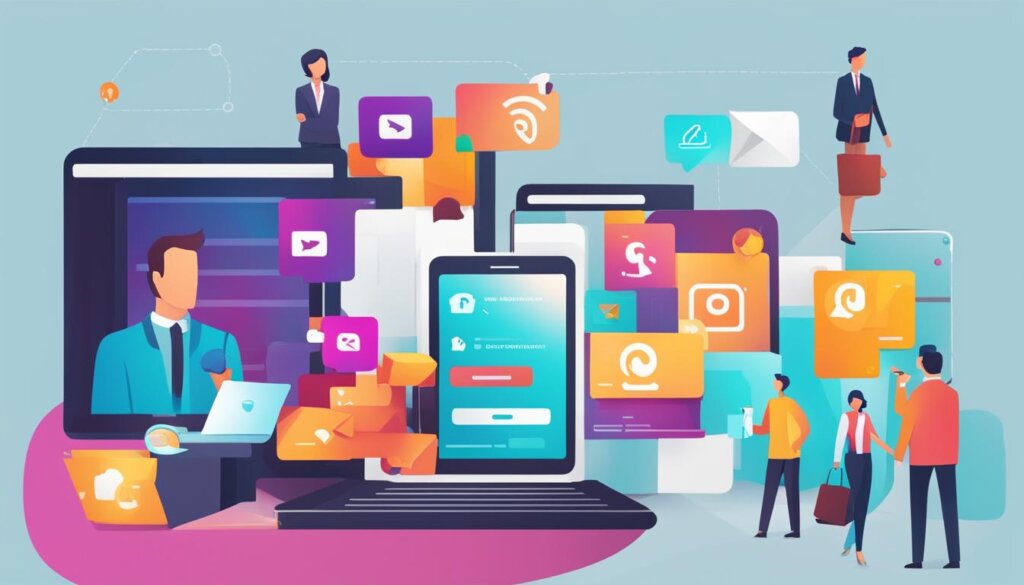Table of Contents
A contact centre is a central point from which organisations manage all customer interactions across various channels. In today’s digital era, customer interactions extend beyond traditional phone calls to include emails, webchats, and social media interactions. Contact centres take an omnichannel approach to refine customer service, increase efficiency, and gain insights into customer behaviour. With their primary functions of offering technical support, customer service, and sales assistance, contact centres have become an essential component of delivering exceptional customer experiences.
By adopting an omnichannel approach, contact centres ensure that customers can get in touch through their preferred channels, ensuring consistent availability and seamless interactions. This multi-channel strategy allows businesses to cater to the diverse needs and preferences of their customers, enhancing customer satisfaction and loyalty. Contact centres also integrate customer relationship management (CRM) strategies to provide a holistic view of customer interactions and enhance personalised interactions.
Contact centres play a vital role in delivering outstanding customer service by providing a centralised hub for all customer interactions. Through their omnichannel approach, they enable businesses to connect with their customers on various channels, ensuring a seamless and consistent experience.
In the following sections, we will delve deeper into how contact centres work, the key features they offer, the differences between contact centres and call centres, and the benefits and types of contact centres available.
How Contact Centers Work and their Key Features
Contact centers play a crucial role in providing efficient and effective customer support. Comprising a team of dedicated agents, contact centers handle omnichannel customer interactions, including calls, emails, chats, and website support. By utilizing advanced technologies like automatic call distributor (ACD) systems, contact centers ensure that multiple calls are efficiently managed while maintaining a positive customer experience.
Real-time reports are an essential feature of contact centers, enabling supervisors to monitor agent performance and customer satisfaction levels. These reports provide valuable insights for continuous improvement and allow for prompt intervention, ensuring quality service delivery. Furthermore, scripted guidelines serve as a framework for agents to provide consistent support and sales assistance, ensuring a standardized customer experience across all interactions.
One of the key strengths of contact centers is the ability to assign interchangeable tasks to agents. This feature allows for collaboration among teams and fosters a dynamic work environment where agents can adapt to varying customer needs. With interchangeable assignments, agents can maintain their individual stations while being prepared to handle different tasks as and when required.
Overall, contact centers are equipped with the necessary tools, technologies, and strategies to provide efficient omnichannel customer support. By leveraging automatic call distributors, real-time reports, scripted guidelines, and interchangeable assignments, contact centers maintain high standards of customer service and ensure seamless customer interactions across all channels.
| Key Features of Contact Centers |
|---|
| Integration of multiple communication channels |
| Automatic Call Distributor (ACD) systems |
| Real-time performance monitoring through reports |
| Scripted guidelines for consistent support and sales |
| Interchangeable assignments for collaborative work |
Contact Centers vs. Call Centers: Understanding the Differences
Contact centers and call centers serve as crucial hubs for customer service, but they have notable distinctions in their operations and capabilities. While call centers primarily handle inbound or outbound calls, contact centers provide omnichannel customer support across various communication channels. This section will delve deeper into the dissimilarities between these two entities, shedding light on their unique features and functionalities.
Call centers predominantly focus on phone interactions and primarily handle customer service, technical support, or sales-related functions. They are often associated with high-volume phone calls and rely heavily on agents fluent in engaging telephonic conversations.
Contact centers, on the other hand, adopt an omnichannel approach to customer support, integrating multiple communication channels such as phone, email, messaging, web chats, and social media. This allows contact centers to provide a more personalized and consistent customer experience, catering to customers’ preferred means of interaction while ensuring seamless connectivity across various touchpoints.
“Contact centers offer a more personalized and consistent customer experience.”
~ Jane Stevens, Customer Support Expert
The integration of omnichannel customer support in contact centers enables customers to engage with customer service representatives through their preferred communication channels, enhancing ease of access and convenience. By being present on various platforms, contact centers can provide a seamless experience, regardless of whether customers choose to connect via phone, email, web chat, or social media.
Contact centers do not limit themselves to conventional customer service functions. They can also be leveraged for telemarketing, information gathering, debt collection, and fraud prevention. This versatility allows businesses to leverage the infrastructural capabilities and agent expertise available in contact centers for various operational and strategic objectives.
Contact Centers vs. Call Centers: A Comparative Overview
To provide a comprehensive understanding of the differences between contact centers and call centers, the following table highlights key distinctions:
| Aspect | Contact Centers | Call Centers |
|---|---|---|
| Channels Supported | Omnichannel (Phone, email, messaging, web chats, social media) | Mainly phone |
| Functions | Customer service, technical support, sales, telemarketing, information gathering, debt collection, fraud prevention | Customer service, technical support, sales |
| Primary Interactions | Inbound and outbound calls, emails, chats, social media messages | Phone calls (inbound or outbound) |
| Cross-Channel Connectivity | High, with seamless integration and consistent customer experience | Focus is primarily on phone interactions |
As showcased in the table, contact centers provide a broader scope of functions and support a range of communication channels, ensuring a higher level of cross-channel connectivity. In contrast, call centers predominantly revolve around telephonic interactions, although they may handle additional tasks, such as customer service, technical support, or sales-related responsibilities.
The next section will explore the benefits and various types of contact centers, unveiling the advantages and considerations that these dynamic customer service hubs bring to businesses.

Benefits and Types of Contact Centers
Contact centers offer numerous advantages over traditional call centers, transforming the landscape of customer service. One of these benefits is the ability for customers to use self-service options, such as instant messaging, text messaging, or chatbots, allowing them to solve problems independently. This not only saves time for customers but also reduces the workload for contact center agents, resulting in improved efficiency.
Another advantage of contact centers is the valuable customer information they gather. By tracking customer interactions across various channels, contact centers can build detailed profiles and gain insights into customer behavior. This information empowers organizations to personalize their customer service and improve the overall customer experience.
Interactive voice response (IVR) systems are another key feature of contact centers. These systems provide automated self-service options, guiding callers through a series of menu options to find the information or assistance they need. IVR eliminates the need for customers to wait for an available agent, further enhancing efficiency and reducing costs.
Furthermore, contact centers have evolved to offer different types to suit the unique needs of businesses. Cloud-based contact centers provide the flexibility to scale operations as required, offering enhanced accessibility and reducing infrastructure costs. Hosted contact centers allow organizations to outsource their customer service operations to a trusted service provider, while virtual contact centers enable agents to work remotely, increasing efficiency and reducing overhead expenses.
FAQ
What is a contact center?
A contact center is a central point from which organizations manage all customer interactions across various channels.
How do contact centers differ from call centers?
Contact centers provide omnichannel customer support, incorporating various communication channels such as phone, email, messaging, web chats, and social media. Call centers primarily handle inbound or outbound calls.
What functions do contact centers serve?
Contact centers offer technical support, customer service, and sales assistance. They can also be used for telemarketing, information gathering, debt collection, and fraud prevention.
What technologies are used in contact centers?
Contact centers utilize technologies such as automatic call distributor (ACD) systems to handle multiple calls, real-time reporting for monitoring agent performance and customer satisfaction, and scripts for effective support and sales.
What are the advantages of contact centers over call centers?
Contact centers save time and money through self-service options like instant messaging, text messaging, and chatbots. They also gather valuable customer information and offer efficient options like interactive voice response (IVR) systems and cloud-based, hosted, and virtual contact centers.
What are the different types of contact centers?
Contact centers can be hardware-based, cloud-based, hosted, or virtual, each with its own advantages and considerations.












